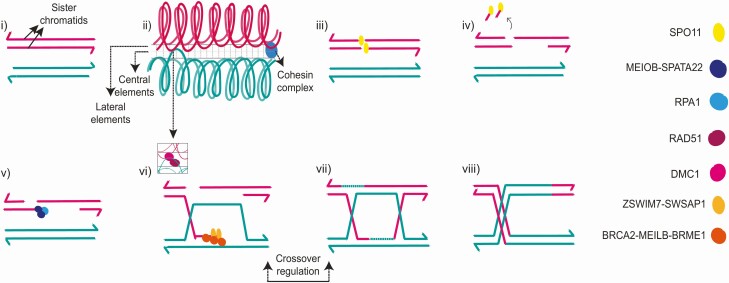Figure 3.
Genes associated with primary ovarian insufficiency (POI) and their relationship with the stages of meiosis I prophase. Genes associated with POI are italicized and in bold in this legend text. (i) Meiosis I begins with homologous chromosomes moving physically close to one another. (ii) The synaptonemal complex (SC) forms between closely apposed homologous chromosomes, composed of central (SYCE1) and lateral (SYCE3) elements and stabilized by cohesin complexes (STAG3, REC8, SMC1B) surrounding the chromatid. (iii) Homologous recombination is initiated by double strand DNA breaks (DSBs) (SPO11). (iv) DSBs are recognized, partially degraded, and act as substrate for homology searching (EXO1). (v) Resected DNA ends are recognized and bound by single-strand DNA (ssDNA) binding proteins (MEIOB) which prevent reannealing. (vi) Downstream binding proteins are then localized to the single-strand tails (BRCA2), which recruit strand-exchange nucleoprotein filaments (RAD51), stabilize and remodel the growing DNA filament (ZSWIM7), and catalyze strand invasion, exchange, and homologous pairing. (vii) DNA exchange intermediates are further processed and joined via DNA repair (MCM8, MCM9, MSH4, MSH5, HFM1). Crossover (pictured) or noncrossover (not pictured) intermediates result. Crossover formation is tightly regulated (BLM, FANCM). (viii) Resolution of crossover and noncrossover intermediates (MLH1, MLH3, EXO1) complete the homologous recombination process. Prophase I concludes with diplotene and diakinesis.

